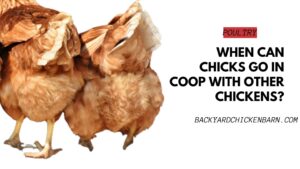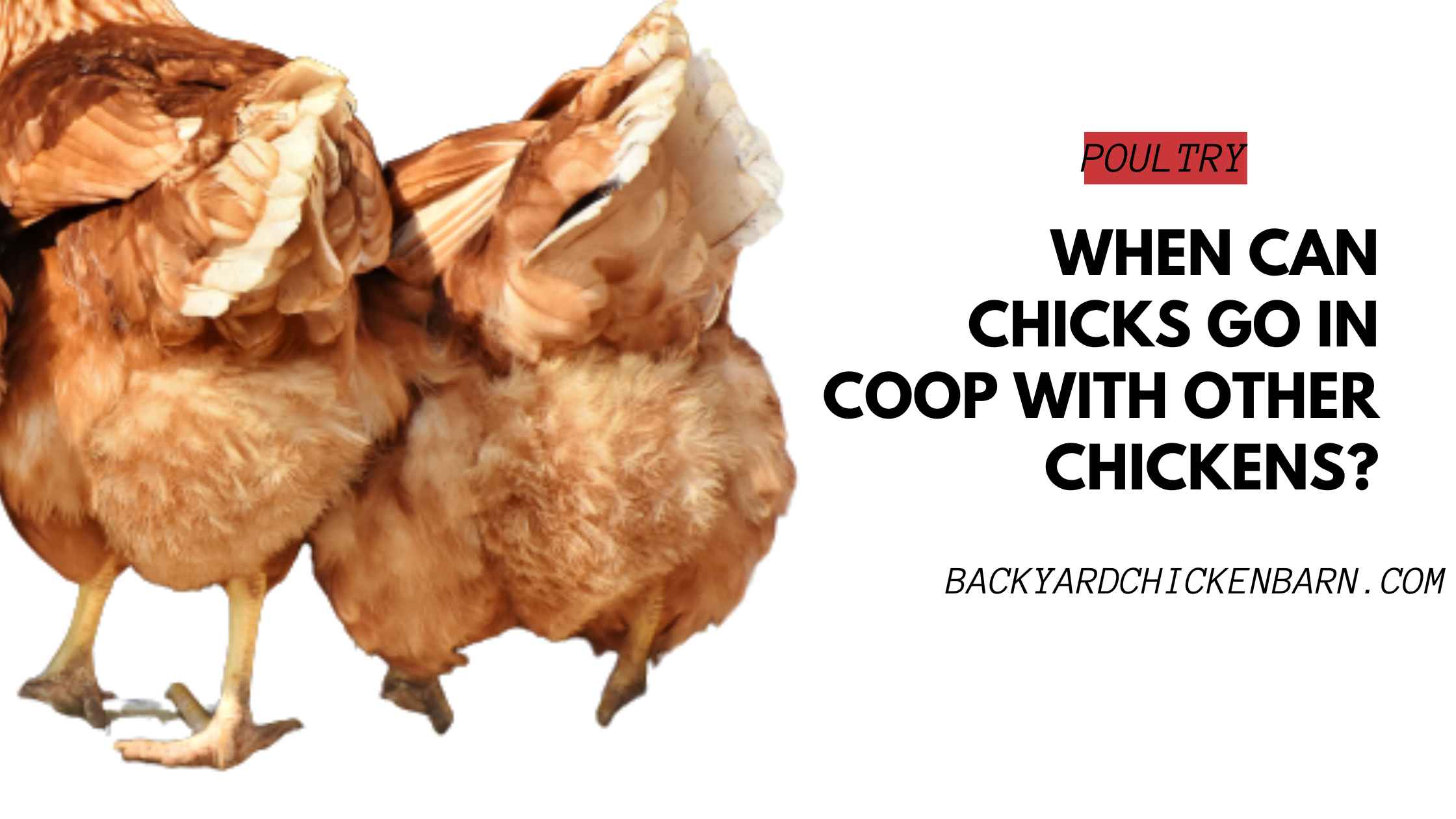When Can Chicks Go in Coop with Other Chickens? [LEARN MORE]
I’ve always had a passion for backyard chicken farming. There’s nothing quite like the clucking of my hens in the morning or collecting fresh eggs for breakfast. But, like many poultry enthusiasts, I’ve often grappled with one crucial question: when is the right time to introduce young chicks to the older flock in the coop?
To cut to the chase, chicks can usually join the primary flock in the coop when they’re about 6 to 8 weeks old. This is when they’ve fully feathered out and can regulate their body temperature efficiently. But the integration process isn’t as simple as just placing them in the coop and hoping for the best.
In my early chicken-keeping days, I made the rookie mistake of introducing a few 5-week-old chicks directly to my flock of mature hens.
The pecking order is real, and it was a sight I never wanted to witness again.
It was then that I realized that age was just one factor; I needed a plan.
To smoothen the transition, I began by setting up a separate area within the main coop using a wire mesh. This allowed the chicks and the older birds to see and get used to each other without any physical contact.
This ‘look but don’t touch’ method worked wonders. After a week or so, there were fewer signs of aggression.
Next, I’d let the chicks out to free-range under close supervision. The vast space meant fewer confrontations and more opportunities for escape. This method also allowed them to find their place in the pecking order gradually.
Another lesson I’ve learned over the years is the power of distractions. Treats like mealworms, vegetables, or scratch grains can divert the attention of the older birds, making them less likely to go after the young ones.
Lastly, I observed the behavior of the flock during the evening when they were naturally more calm and getting ready to roost. This quiet time was ideal for introducing the chicks without much fuss.
The journey of integrating chicks with older chickens can be challenging, but with patience, observation, and a well-thought-out strategy, harmony is achievable.
Every flock has its dynamics, and understanding this is key to successful integration. So, fellow chicken enthusiasts, arm yourselves with knowledge and patience, and remember, it’s all part of the delightful world of chicken keeping.
ALSO SEE: How to Keep Squirrels out of Chicken Coop

FAQs: Integrating Chicks with Older Chickens
- At what age can chicks be introduced to the main coop?
- Chicks can typically be introduced when they’re about 6 to 8 weeks old.
- Why is the 6-8 week age range recommended for introducing chicks?
- By this age, they have fully feathered out and can regulate their body temperature efficiently.
- Is it safe to directly place young chicks with mature hens?
- No, direct introduction can lead to aggressive behavior due to the pecking order.
- What’s the ‘look but don’t touch’ method?
- It involves setting up a separate area inside the main coop with wire mesh, allowing chicks and older birds to see each other without physical contact.
- How long should the ‘look but don’t touch’ method be employed?
- Typically, about a week or until there are fewer signs of aggression.
- Is free-ranging a good idea for chicks?
- Yes, under supervision, free-ranging provides more space, leading to fewer confrontations.
- How does free-ranging help with the pecking order?
- It allows chicks to gradually find their place in the pecking order with less risk.
- How can you distract older chickens during integration?
- Offering treats like mealworms, vegetables, or scratch grains can divert their attention.
- When is the best time to observe flock behavior for integration?
- The evening is ideal as the birds are more calm and getting ready to roost.
- Is the pecking order real?
- Yes, chickens have a hierarchical system which they establish through pecking.
- Why is understanding the flock dynamics crucial?
- Because every flock is different, understanding its dynamics is key to successful integration.
- How long should chicks free-range under supervision?
- Until there are clear signs of acceptance by the older birds and reduced aggression.
- Can chicks regulate their body temperature right after hatching?
- No, they gain the ability to regulate their body temperature as they fully feather out.
- What happens if you introduce chicks to the coop too early?
- They may be bullied or attacked due to the established pecking order among mature chickens.
- Are there signs of aggression to watch out for during integration?
- Yes, pecking, chasing, or cornering are signs of aggression.
- What is the main goal when introducing chicks to a mature flock?
- The primary aim is to achieve harmony within the flock.
- Is the pecking order established only once?
- No, the pecking order can shift and change as new birds are introduced or as birds mature.
- How does the wire mesh help in the ‘look but don’t touch’ method?
- It provides a barrier preventing physical contact, while still allowing birds to see and get used to each other.
- Should you always use the ‘look but don’t touch’ method?
- It’s a recommended method, but different flocks may have unique needs, so observe and adjust accordingly.
- Why is the evening an ideal time for introducing chicks?
- Chickens are naturally calmer and preparing to roost during the evening.
- Do all older chickens show aggression towards chicks?
- Not all, but some might due to the pecking order and territorial behavior.
- Can you introduce a single chick to a mature flock?
- It’s riskier as the chick might be singled out. It’s often better to introduce chicks in groups.
- Do chickens remember introduced chicks after the ‘look but don’t touch’ phase?
- Yes, the phase helps familiarize them with the new additions, reducing potential aggression.
- Are there specific treats that are more effective for distraction?
- Chickens love mealworms, but vegetables or scratch grains can also work. It depends on the flock’s preference.
- How can you tell if chicks are fully feathered out?
- They will have a complete set of adult feathers and no longer exhibit the fluffy down of young chicks.
- Why is regulating body temperature crucial for chicks?
- Regulating body temperature helps them survive in varying environmental conditions without the need for external heat sources.
- Do chicks need a heat source in the coop?
- Up to the age of 6-8 weeks, they typically do. Once they’re fully feathered, they can regulate their temperature.
- What should you do if an older chicken continues to bully a chick?
- Separate the aggressive chicken for a while or ensure the chick has places to hide.
- How do you establish a pecking order in a new flock?
- Chickens will establish this naturally over time through interactions.
- How long does it take for chickens to accept new chicks?
- It varies, but with proper introduction methods, it can take a week or more.
- Is it better to introduce multiple chicks at once or one at a time?
- Introducing in groups can distribute any aggressive behavior, making it safer for the chicks.
- Can roosters help in the integration process?
- It depends on the rooster. Some may protect the chicks, while others might be aggressive.
- Why are distractions important during integration?
- They can divert the attention of older birds, reducing the chance of aggressive behaviors toward the chicks.
- How can you ensure chicks are safe during free-ranging?
- Supervise the sessions and provide plenty of hiding spots for chicks.
- Are there breeds of chickens more accepting of chicks?
- Some breeds are more docile, but individual bird temperament can vary.
- Is it a good idea to introduce chicks of different ages at the same time?
- It can be done, but monitor closely as older chicks might bully younger ones.
- What if the older flock rejects the chicks even after the introduction period?
- Extended separation and reintroduction might be needed, or you may need to consider separate housing.
- Can the ‘look but don’t touch’ method be used in open spaces?
- It’s best employed within a confined area like a coop for effectiveness.
- How often should you check on chicks after they’ve been integrated?
- Regularly, for the first few weeks, to ensure their safety and well-being.
- Can you use the ‘look but don’t touch’ method for integrating other poultry like ducks?
- Yes, the method can be adapted for different poultry, but always observe and adjust based on specific needs.


